Last updated on December 30th, 2023 at 02:59 pm
A very common yet reasonable question to ask yourself is whether you should buy an Audio Interface or a USB Mixer for your home studio, but you could certainly do both, so why not just buy a Mixer with an integrated Audio Interface?
In this post, I will go over 8 Mixers that have an integrated Audio Interface which will allow you to use them not just for live performances but also to do multitrack recordings in your home studio. Some of them can even record onto an SD card.
This combination of equipment isn’t that cheap, so when I say affordable, I’m talking about $300 and up, but you are getting two for the price one at a still very reasonable price.
What is the best Multitrack USB Mixer for your Home Studio?
Out of all the picks on this entire list, I would have to choose the Soundcraft Signature MTK 22 mixer. Of course, there’s a smaller 12-channel version available also, but I think that the MTK 22 simply is more cost-efficient.
The recording quality is outstanding and the overall number of built-in features it comes with, as well as all of the included software, just makes it a very appealing option.
Here’s a link to where you can get it:
- Soundcraft Signature MTK 22: Amazon, Sweetwater, Guitar Center.
Read also: Best Home Studio Mixers; Analog & Digital.
Let’s get right into the first one on this list…
1. Soundcraft Signature MTK 12 and 22 Series
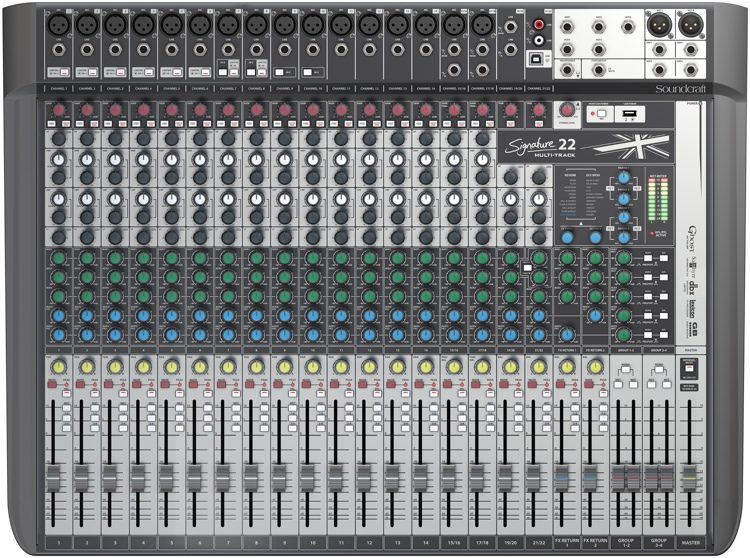
The Signature MTK 12 and 22 series from Soundcraft are analog mixers that also come with onboard effects and USB multi-track recording and playback. They both allow for 12 or 22 multi-track recordings respectively.
It is important to make the distinction between the MTK series and the regular ones;
Both can be connected to the PC via USB but the regular ones only offer two channels for stereo recording and support 24-bit/192kHz resolution, while the MTK ones offer 12 or 22 Multi-track recording but at a reduced 24-bit/48kHz sample rate.
The MTK series are fantastic for anyone who is building a home studio and wants a good Mixer with loads of inputs and options.
They have the Ghost preamps, which are the ones featured on their Ghost Consoles which are the top of the line. They are of extremely good quality giving you a lot of headroom, a wide dynamic range, and a good signal-to-noise ratio.
These preamps also come with a Sapphyre Asymmetric EQ, which has two separate mid-bands, allowing you to EQ everything thoroughly.
This Mixer’s interface will also allow you to use the plugins on your DAW for actual live performances in real-time as well as for studio monitoring without any latency at all.
They come loaded with studio-quality effects from Lexicon like Reverb, Delay, Chorus, Modulation, and other effects and dbx limiters on the input channels.
One would think that these effects are not that good and just here to add something to this mixing desk, but not only do they sound great, even better than some commercial plugins, but they are also extremely easy to set with just a pair of parameter knobs.
The consoles have XLR and switchable Hi-Z inputs that enable guitars, basses, and other instruments to be directly connected.
The quality of the faders is extremely good, they are really smooth, responsive, and accurate.
You get a 48v Phantom Power control, which is global, and also a High-Pass filter (for all mono inputs).
The channel strips have a total of 16 mono and 4 stereo channels, 2 effect busses, 4 group busses, and a master fader.
USB Interface Compatibility
- PC: Supports Windows 7, Windows 8, and Windows 10.
- Mac: Supports Mac OS 10.7.x Lion through 10.11.x El Capitan
Included Software
- Free downloads of the Lexicon MPXL native plug-in and Ableton Live 9 Lite.
The Soundcraft Signature MTK 12 and 22 Series are simple and easy to use, the recording quality is extremely good and they will serve you well either for live performances or in your home studio.
Find out more about the Soundcraft Signature MTK Series here:
- Soundcraft Signature MTK 12: Amazon, Sweetwater, Guitar Center.
- Soundcraft Signature MTK 22: Amazon, Sweetwater, Guitar Center.
If you find that buying a mixing board like this one is either too expensive or simply too much for what you actually need, you can always read this article I wrote on the best Audio Interfaces under $300 which offer great recording quality at an affordable price!
2. Allen & Heath ZEDi 10FX
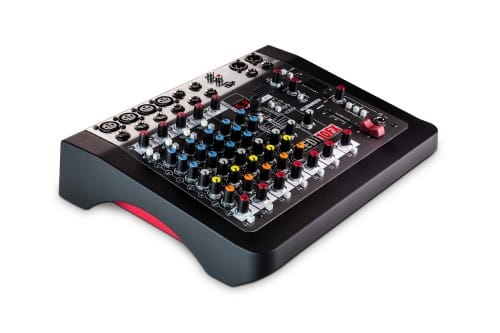
Another excellent addition to any Home Studio is the Allen & Heath ZEDi 10FX.
This one I would recommend to anyone with a small Home Studio, or to anyone who doesn’t need an extreme number of ins and outs.
This mixer is also a lot more affordable than all the previous ones on this list which is a clear pro.
It is a 4×4 mixer, meaning that you can record the four mic inputs on separate tracks in your DAW.
The sample rate and bit depth are 24-bit / 96kHz which is perfect for home recording applications.
ZEDi-10FX offers four mono mic/line channels (with phantom power), which are the ones that can be recorded separately onto the DAW, plus two stereo inputs as well as built-in FX.
The four mono channels feature balanced/unbalanced TRS and XLR inputs and use the GSPre preamps, which sound pretty damn nice and can even provide enough gain to drive microphones like the Shure SM7B or the Heil PR40.
The stereo Inputs come via TRS.
The first two channels also include a “guitar mode” which engages the high impedance DI inputs. This means that you won’t need to worry about purchasing a DI box.
The next two channels, 3 and 4, have a Line/Pad button which will drop the input level by 20dB.
All four channels have a Low cut button as well as the typical controls every mixer has; like Gain, balance, FX-Send, mix level, Aux sends, and a three-band EQ.
When taking a look at the stereo channels you will notice that they aren’t as fully equipped as the mono ones:
The first stereo channel only supplies up to 15dB of gain as well as a two-band EQ, while the second stereo channel only offers mix-level control.
Luckily, the effects sound great, with 61 one presets in total split between the typical effects such as delay, reverb, chorus, doublers, flangers, and more.
This mixer also comes with a ¼” headphone output which should be able to drive most headphones out there.
Included Software
One huge perk about this mixer is that it comes with these free included software; Cubase LE and Cubasis LE.
Lastly, this mixer feels very solid. It’s clearly been made to last and to be road tough.
Features
- 4 in, 4 out USB Audio Interface (24-bit/96kHz)
- Cubase LE Software included
- Cubasis LE App included
- 2 Stereo Inputs with TRS jack sockets
- 2 Guitar DI high impedance inputs
- Internal FX
Note: You might also want to check out the Allen & Heath ZEDi-10 which is the same mixer only cheaper, but it lacks the effects.
Find out more about the ZEDi-10FX and the ZEDi-10 here:
- ZEDi-10FX: Amazon, Sweetwater, Guitar Center.
- ZEDi-10: Amazon, Sweetwater.
Depending on your needs you might want one or the other.
3. Presonus Studiolive ARc
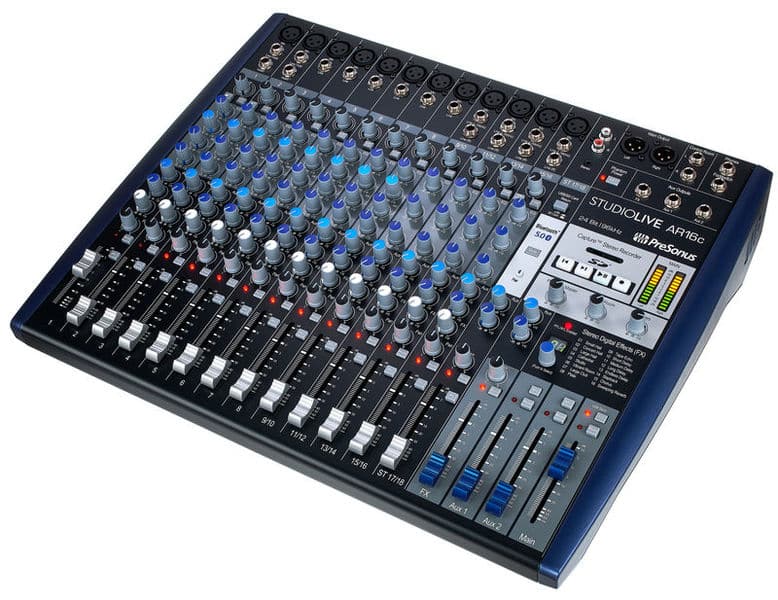
The StudioLive ARc series by Presonus offer a wide selection of mixing desks ranging from 8 tracks all the way up to 18, and all of them are capable of Multi-track recording, sending every Input to your DAW plus the Main mix channels.
These mixers have a nice feature that they call the “super-channel”, which basically gives you all the inputs on one channel that you could possibly need; RCA (for CD and DVD players), a 1/8” mini-jack (for plugging in your phone, tablet, etc.) and even Bluetooth to pair the mixer with your phone, tablet, laptop, etc.
One other benefit of the Presonus StudioLive ARc Mixers is that they can record directly to an SD card (the stereo mix only), negating the need for a computer when recording live.
Channels 1 and 2 have high-impedance inputs for instruments, such as electric guitars and basses.
The Presonus Studiolive ARc mixers provide you with 16 high-quality effects, which include reverb (room, hall, and plate), chorus, delay, and more.
All of these Mixers can record up to 24-bit/96kHz and you also get a 48v Phantom Power control switch which enables it globally.
Included Software
- Studio One artist Edition (Presonus DAW) and Studio Magic Plug-in Suite for Mac and Windows, which includes seven Plugins in VST, AU, and AAX formats.
The StudioLive AR mixers are definitely a great investment for a Home Studio, especially if you need to record a vast number of simultaneous inputs, or if you need a board that can be used both live and in the Studio.
Find out more about the PreSonus StudioLive ARc series here:
- StudioLive AR8c: Amazon, Sweetwater, Guitar Center.
- StudioLive AR12c: Amazon, Sweetwater, Guitar Center.
- StudioLive AR16c: Amazon, Sweetwater, Guitar Center.
Related: I’ve put together a list of some amazing Wireless Mixers which you should definitely check out!
4. Zoom LiveTrak L-12

The Zoom LiveTrak L-12 will allow you to record up to fourteen individual tracks to your DAW or to an SD card.
The first 8 tracks have XLR inputs, one and two having a Hi-Z instrument-level input while the remaining six have pads, which allow you to reduce the incoming level by 26dB.
The final two channels are stereo inputs which can be on ¼” TRS jacks or RCA connectors.
There are fourteen tracks being recorded because you get the 12 inputs as well as the master output, which is stereo.
The Zoom L-12 can also be used to overdub additional parts either in your DAW or internally. The maximum recording quality of this mixer is 24-bit/96kHz.
This one is different from the other ones on this list because it provides 5 headphone outputs and you can create different mixes for each one of them. Each of these outputs has individual volume control also.
Each of the mono inputs (channels 1-8) includes a one-knob compressor and a 3-band EQ with sweepable mids. You can choose from a variety of effects to add to the tracks while also being able to add a Low-cut. Every channel also has a pan control.
Each channel strip can operate in three different modes; In Audio Interface mode the L-12 transforms into a 14-in/4-out USB interface for your device with flexible routing options.
In USB mode, you can transfer projects and files to a connected drive.
Card Reader mode allows you to transfer files to and from your computer.
The L-12 has the auto-record function, which will basically start recording as soon as it detects a certain dB level.
There’s also a bigger version that supports up to 20 channels. Here’s the link to the Zoom LiveTrak L-20.
It does everything you need it to do, be it recording a live band, rehearsals, or even just for doing some solo home recording, this mixer will do everything while still being very easy to use and intuitive.
Find out more about the Zoom LiveTrak L12 & L-20 here:
- Zoom LiveTrak L-12: Amazon, Sweetwater, Guitar Center.
- Zoom LiveTrak L-20: Amazon, Sweetwater, Guitar Center.
Another option would be to go for one of these two Audio Interfaces which are affordable and have a decent amount of inputs.
5. Zoom R16
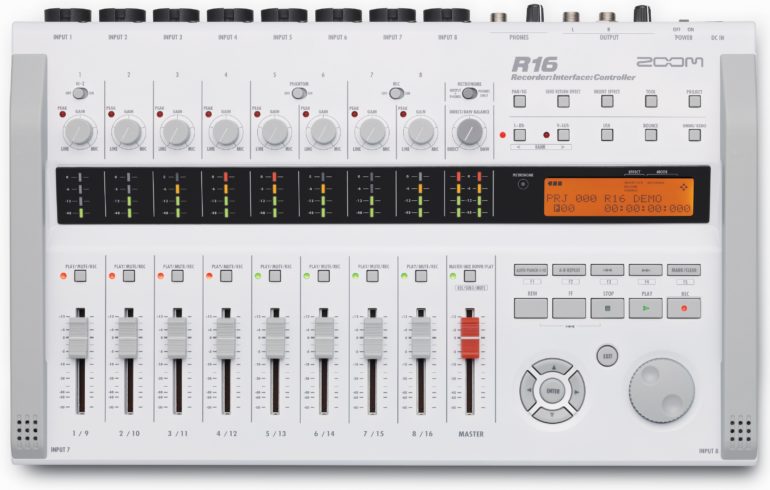
This Mixer is a standalone multi-track recorder and a 2.0 USB computer audio interface as well as a battery-powered field recorder.
The first thing that stands out is its size, it’s very compact, thin, and light.
You can record a full live band and overdub up to 16 tracks, without ever touching a computer.
Or, you could record ambient sound and use it for a slide show if you’re a photographer, or it can even be really useful for film-making since you can record voiceovers.
It features built-in condenser microphones as well as inputs for 8 external microphones and it can record up to 24-bit/96kHz audio quality!
The quality of the preamps is really high and they are actually very quiet.
This isn’t your traditional mixing board from what you can see, it packs a lot of extra features like 135 Built-in effects such as guitar amp modeling to even mastering effects.
These effects can only be used in standalone mode, or when recording onto the PC.
The reverb, delay, chorus, and flange are amazing. The EQ, while being very basic, still does its job and the amp modeling is really fun and sounds pretty good also.
The Zoom R16 also provides a chromatic tuner and metronome.
One cool benefit it has is that it can be used to control the DAW, instead of using your mouse to increase or lower the volumes of the tracks, you can simply use the faders on the R16 and this will adjust it on your PC.
One issue though, which is quite a big deal actually, is that only channels five and six can provide phantom power for condenser microphones.
Channel One has a Hi-Z instrument-level switch, which allows you to directly connect a guitar or bass.
Included Software
- Cubase LE
The Zoom R16 is really versatile and I would absolutely recommend it to anyone in need of something portable that can be battery powered as well, should you need to record on the road, in a bar, etc.
A huge plus about the Zoom R16 is that it can work as a control surface for your DAW, which offers a more “hands-on” approach to mixing.
Find out more about the Zoom R16 here:
- Zoom R16: Amazon, Sweetwater.
6. Behringer XR18
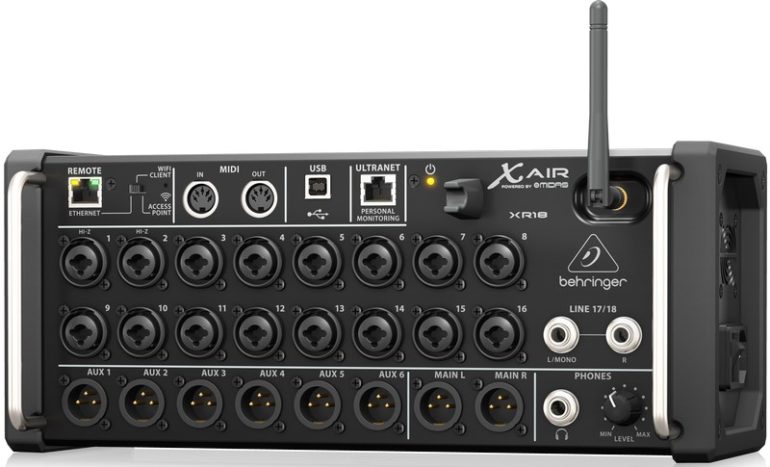
The Behringer XR18 is a digital mixer that features an 18-in/18-out USB audio interface.
It’s a completely different mixer than the other ones on this list for the simple fact that it doesn’t provide any channel strips or analog controls.
The way it works is via Wi-Fi by connecting it to a device like an iPad, Android Tablet, Laptop, etc. through the X-Air App.
This app works almost like a DAW and comes included with loads of effects.
It even has an Auto-Mix feature which can manage fully automated mixes with up to 16 live microphones…
This feature is not really intended for mixing live music, but rather conferences.
16 of the inputs are XLR/TRS combo Jacks which feature their famous MIDAS preamps, and an additional two line inputs, as well as MIDI I/O.
The quality of these preamps is actually pretty good, providing you with an excellent signal-to-noise ratio and good headroom.
It also comes with 6 aux outputs which can be used to create headphone mixes, or for live monitoring, as well as a headphone output.
Lastly, it comes with the “Ultranet” port which connects to the Behringer’s P16 monitor distribution system and allows every musician to create their own headphone mix or their own monitor mix on stage.
When it comes to cost-efficiency, the Behringer XR18 is one of the best ones…
It is super affordable and it can be used from a distance, which is excellent for live performances since you won’t have to deal with loads of cables.
Find out more about the Behringer X-Air XR18 here:
- Behringer X-Air XR18: Amazon, Sweetwater.
7. Behringer X32
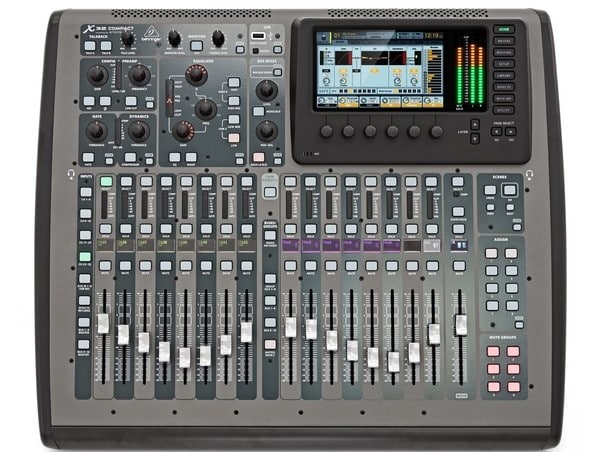
The Behringer X32 is a 40-input compact mixer that features a 32X32 Audio Interface, meaning that you can record 32 separate tracks on/to your DAW.
This mixer comes with the MIDAS preamps, which are Behringer’s award-winning preamps that sound pretty damn good.
One cool little pro about this mixer is that it features an already built-in talkback mic. You can, however, use an external one for this.
With the number of ins and outs that this mixer has, you shouldn’t run into any troubles, but if you need more then you can simply use the expansion slot for an additional 32×32.
As far as effects go, it comes with eight true-stereo (16 mono) multi-effects processors including delay, reverb, and all the traditional ones, as well as a 31-band graphic EQ.
Additionally, it has the Auto Mix function which enables automatic gain sharing, providing increased gain to your main speakers while ducking open mics.
It’s also possible to control the volume, panning, EQ, and effects via Ethernet or Wi-Fi by using a dedicated app, making this mixer very desirable for live settings since you don’t need to always be right beside it; you can simply walk around the venue and tune everything from a distance with your tablet or iPad.
Now, this one is a bit more expensive than all the mixers I’ve listed so far, but it has loads of ins and outs, and you can control it wirelessly, which is a clear pro.
Included Software
- Tracktion 4
If you absolutely need a super versatile console, then the Behringer X32 might be the right one; However, in most cases, I would recommend the first one I listed in this post.
Learn more about the Behringer X32 here:
- Behringer X32 Producer: Amazon, Sweetwater.
8. Tascam Model Series Mixers

The Tascam Model 12, 16, and 24 are true hybrid mixers that have all the controls an analog console has to offer, as well as some extra digital features.
They can record 8, 12, and 22 simultaneous tracks directly to your DAW or to an SD card at a maximum quality of 24-bit/48kHz.
On the first two channels, you get an Instrument/Line-in jack with the ability to switch between them with the press of a button. Also, those two channels have an extra insert on the front.
They all can record either to your DAW or to an SD card, and also offer immediate playback of the tracks you recorded to the SD card.
Just like the Presonus StudioLive AR series, the Tascam Model Series come with RCA, minijack, and Bluetooth connectivity for streaming audio, and they even provide 16 built-in effects such as Reverb, Chorus, Delay, Flanger, etc.
The Phantom Power can be supplied globally, sadly not individually, but this shouldn’t be that much of an issue.
One distinctive feature is the Routing Mode selector, which is common to all channels;
It allows you to assign the input of your choice, like the live incoming signal, the return from a DAW channel or the return from the internal multitrack recorder to each channel for EQ, processing, etc.
This enables you to overdub in the studio or to play backing tracks, etc.
Additionally, they come with a 3-band EQ with Sweepable mids, plus a low-cut on those same channels. On the rest of them, you only get a regular 3-band EQ plus the low-cut.
A stereo 7-band graphic EQ can be additionally applied to the main mix or monitor output, which lets you shape your mixes to your liking and prevent feedback.
Lastly, one feature unique to only the Tascam Model 12 is the DAW control Mode, which will transform the mixer into a control surface for all major DAWs.
The Tascam Model 12, 16 and 24 series are some of the best mixers you could get for your home studio, especially the Model 12 thanks to its built-in DAW control mode.
Learn more about the Tascam Model Series here:
- Tascam Model 12: Amazon, Sweetwater, Guitar Center.
- Tascam Model 16: Amazon, Sweetwater, Guitar Center.
- Tascam Model 24: Amazon, Sweetwater, Guitar Center.
Best Wireless Multitrack Mixers
Here I will list just a couple of the mixers that not only can record multitracks but also work wirelessly. I have a huge and very detailed post about the best wireless Mixers that you should absolutely read but will include just a couple in this article as well.
Soundcraft UI24R
Best Wireless Mixer that includes a built-in amp modeling software.

This wireless mixer features a 24-in/24-out audio interface, which means that every single track can be recorded separately onto your DAW.
Let’s take a quick look at the inputs and outputs:
Inputs: It comes with 10 x XLR/1/4″ combo jacks, as well as 10 x XLR jacks all equipped with their Studer-designed preamps.
Not only that but there’s an additional 1 x stereo RCA connection.
Outputs: It comes with 2 x XLR and 2 x 1/4″ main outputs, as well as 8 x XLR (aux outs), and lastly 2 x ¼” headphone outputs.
The first two inputs are also Hi-Z inputs which feature DigiTech’s amp modeling.
These inputs are designed to connect an electric guitar/bass directly to the mixer without the need of using a D.I. box.
This can definitely come in handy during live gigs where you don’t want to take guitar amps along, since these amp sims actually sound quite convincing.
The great thing about the Soundcraft wireless mixers is that you can connect to them through Wi-Fi and control their internal software via any HTML5-compatible browser…
And basically, every device out there can run such a browser (Chrome, Firefox, Safari, etc).
In this image you can see how the software actually looks;
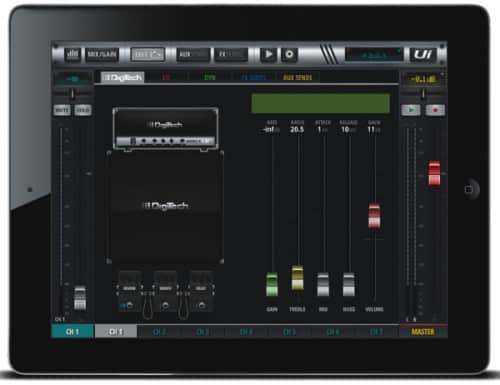
Note: It also has an Ethernet port, should you want to take wired control of this digital mixer via your computer or laptop.
Most wireless mixers require you to download an app, but with the Soundcraft mixers you just connect to the Wi-Fi they provide, and that’s it!
Not only that, but you can connect up to 10 different devices, which means that every band member can control their own effects, monitor mix, amp sim, etc.
There is even an HDMI output and an extra USB port so that you can hook up a monitor and mouse if you want to control it that way.
Moving on…
Onboard Effects
This mixer comes with the Lexicon effects, which include; reverbs, delay, and chorus.
Each channel has also Compression, de-essing, and noise-gating built-in, plus a real-time frequency analyzer.
As I mentioned earlier, amp emulation for the first two inputs is also included, which provides a huge array of amps, cabinets, pedal effects, and more.
Find out more about the Soundcraft UI24R here:
- Soundcraft UI24R: Amazon, Sweetwater, Guitar Center.
Behringer X Air XR18

The Behringer XR18 is a digital mixer that features a 18-in/18-out USB audio interface.
This basically means that every input can be recorded onto its own track in the DAW.
16 of the inputs are XLR/TRS combo Jacks which feature their famous MIDAS preamps, and an additional 2 x TRS line inputs, as well as MIDI I/O.
The quality of these preamps is actually pretty good, providing you with an excellent signal-to-noise ratio and good headroom.
Both of the first two inputs are also Hi-Z inputs, which allow you to connect an electric guitar without the need of using a D.I. box.
As far as the outputs go, it comes with 2 x XLR Main outputs, the UltraNet port, 6 XLR Aux bus outs, and ¼” TRS headphone output.
The 6 aux outputs can be used to create headphone mixes, or for live monitoring…
While the “Ultranet” port, which connects to the Behringer’s P16 monitor distribution system, allows every musician to create their own headphone mix or their own monitor mix on stage.
The Behringer X-Air XR18 can be controlled via Wi-Fi -with a built-in router- or ethernet, using an Android or iOS device via the X-Air App, which gives you an overview of what’s going on in the mixer.
This app works almost like a DAW and comes included with loads of effects.
It even has an Auto-Mix feature which can manage fully automated mixes with up to 16 live microphones…
This feature is not really intended for mixing live music, but rather conferences.
When it comes to cost-efficiency, the Behringer XR18 is one of the best wireless multitrack mixers out there…
It is super affordable for what you are getting.
Onboard Effects
As far as the effects go, it comes with four built-in true-stereo (8 mono) multi-effects processors, including delay, chorus, and dynamics, as well as a 31-band EQ.
You can also choose any combination of high-end simulations of classic studio reverbs such as the Lexicon 480L and PCM70, the EMT250, or Quantec QRS.
Sadly, there is no included feedback rejection/feedback fighting on these mixers.
Find out more about the Behringer X Air XR18 here:
- Behringer X Air XR18: Amazon, Sweetwater.
Mackie DL16S and DL32S
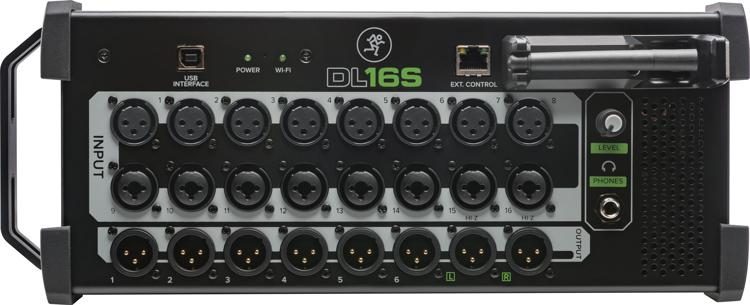
The Mackie DL16S and DL32S are wireless digital mixers that feature a 16-in/16-out and 32-in/32-out audio interfaces respectively.
All of the inputs come with the Onyx+ preamps which are one of the best preamps out there and should provide you with a lot of headroom and a great signal-to-noise ratio.
Speaking of inputs, let’s take a look at them right now, as well as the outputs…
The inputs on the DL16S are: 8 x XLR inputs, 6 x XLR/TRS combo jacks, 2 x XLR/TRS Combo Hi-Z inputs.
The outputs are 2 x XLR Main outputs, 6 x XLR (Assignable) outputs, and a 1 x ¼” TRS headphone output.
The inputs of the DL32S are: 16 x XLR inputs, 14 x XLR/TRS combo jacks, 2 x XLR/TRS Combo Hi-Z inputs.
The outputs are: 2 x XLR Main outputs, 8 x XLR (Assignable) outputs, and a 1 x ¼” TRS headphone output.
Both of these mixers are controlled via Mackie’s “Master Fader App” which can be used on almost any iOS, Android, Mac, or PC device.
What this means is that you can set the mixer up on stage and control it from anywhere you’d like.
The same goes for your home studio since you can set it up in a way where it’s completely out of the way, and then all you need to do is use the app to control it.
This app is fairly easy to use since it’s extremely intuitive, but if you want to see a video of how it works, then either scroll back up the review of the Mackie DL1608, or click on this YouTube link.
Both mixers allow for up to 20 simultaneous Wi-Fi connections, which is way more than any of the mixers I’ve mentioned so far.
The great thing about being able to have so many devices connected simultaneously is that the band members who are playing on stage can actually control their own monitor/headphone mix without needing to bother the engineer.
These mixers also allow you to play back music during intermissions, backing tracks, etc. and they also allow you to play back the full multitrack recording for a virtual soundcheck.
Onboard Effects
Each input comes with a 4-band parametric EQ, highpass filter, noise gate, and compression.
While each output comes with a 4-band parametric EQ, highpass and lowpass filters, 31-band graphic EQ, compressor/limiter, and alignment delay.
Additionally, the mixer provides reverb, delay, and modulation effects.
Sadly, there’s no Feedback Control built into it.
Find out more about the Mackie DL16S and DL32S here:
- Mackie DL16S: Amazon, Sweetwater, Guitar Center.
- Mackie DL32S: Amazon, Sweetwater, Guitar Center.
Conclusion
No matter which of these Mixers you choose, you will be able to do multi-track recording, however, not everyone is going to need the same Mixer.
Depending on the number of inputs you need, you’re going to want a different one. Also, you need to take the budget into account.
My top picks would be the Soundcraft Signature MTK 22 and the Allen & Heath ZEDi 10FX, depending on the number of channels you need, and you can find them both on my recommended gear page.
The Zoom Live-Trak L-12 is also a mixer that shouldn’t be overlooked.
If you think that you are going to need an upgrade in the future, simply get a mixer with a higher channel count, you will be saving money in the long run.
This depends on the mixer itself; if it has a built-in audio interface that is capable of recording multiple tracks, then yes.
You can check this by looking at the “Computer Connectivity” specifications; If it says 16×16, for example, then this means that 16 tracks are coming in and 16 are going out, meaning that those can be recorded individually on your DAW.
In most cases NO. You can use one with a built-in audio interface, but unless you need all the tracks a mixer has to offer, then it makes much more sense to go with an Audio Interface.
Mixers that can do multitrack recording are also very expensive.
You will need a mixer with a built-in audio interface that is capable of multitrack recording. These mixers are usually far more expensive than regular ones, and for a home studio you probably don’t need them anyway.
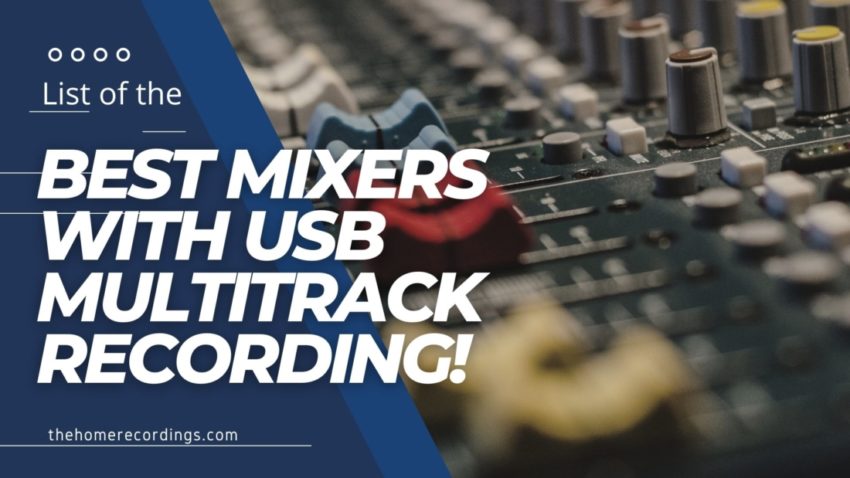

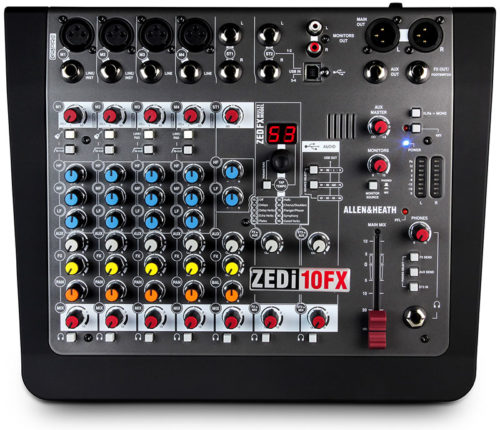
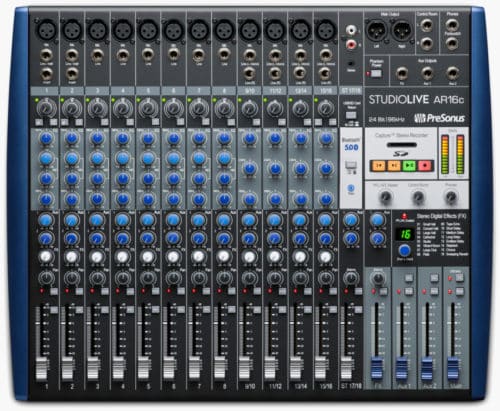
This article really helped answer some questions. Thanks!
I only recently discovered usb multi-tracking capabilities, and since my Mackie ProFX8 has too few channels for my expanding instrument collection, I’ve been researching my next purchase. For me, integration with the latest Mac OS and running Logic X is a must, so the Soundcraft MTKs are out. Now I see Mackie’s new line of Onyx mixers are coming out. They seem to have everything I need, but how long do we have to wait before they ship?
The soundcraft 12MTK and 22MTK are not as good as old Soundcraft boards. I had a 32 track, a 22 track and a 12 and all stopped working within 3 years of purchase or the channels died. Not very impressed. Allen and Heath have the best sound quality and recording dynamics.
Hi!
I use a Presonus StudioLive 24.4.2. in my bigger Studio and an (elderly) Alesis Multimix 16 for smaller sessions.
Both into Presonus Studio One 5 DAW.
They both perform great and have no problems with Win 10.
Hi Ken. My name is Jymme Foote, and I’m a songwriter/podcaster among other things, in central California. I’m doing research on multitrack usb mixers and saw your post. Just thought I’d say hello.
I am here to replace my original Alesis Multimix 2.0 USB. Sadly discontinued indeed. The driver does not quite work with Windows 10 anymore 🙁
I would have taken that A&H Zedi 10FX as a direct replacement but that 4×4 limit is putting me off.
I don’t like the Zoom R16 as I have used one and the Presonus is too big. The 12 channel SoundCraft is also too large to be portable for me as are the others so it looks like the best replacement for the Alesis Multimix USB 2.0 is the Zoom Live Trak L12 to my eye.
Thanks for the list, it is very good and comprehensive. You have just saved me some serious time researching this.
A big mistake in this article is to omit that the recommended Soundcraft Signature MTK 22 USB Interface Compatibility just supports Mac OS 10.7.x Lion through 10.11.x El Capitan. Does not have support for macOS Catalina or higher!
The update to the Zoom R16 is wrong. I record 8 individual tracks at once into Reaper using my Zoom R16 over USB. I cannot control the volume of each track using the R16 faders though – it is a straight pass-through from the gear when it is in USB mode.
I don’t know what other people are doing but they’re clearly doing it wrong if they can only get a stereo mix.
i would also really like to know wich of these mixers allows me to record seperate audio tracks to my daw with the effects (or just eq/panning) from the mixer. i want to use it to make a pre mix and finish it off in my daw. seems like you cant so that with the zoom l12 for example.
Hi, can you or anyone recommend a mixer, I can plug in 3 different keyboards and play through a pair of monitors. Many thanks
It’s on the list bro. The Tascam Model 24 and the new version Model 16
Hi, thanks for informative article. Question: When multitracking to daw/SD, do all these mixers send the signal pre EQ, fader etc? Thanks
Thanks for the helpful info. I’m a decent musician, but relatively new to home recording and am trying to find the right affordable mixer to use in my Win10 Reaper DAW environment. It’s important to be able to multitrack for live studio jams.
Hi, nice article!
Really helped to start my search for a budget mixer that still packs a punch.
However, the Alesis can only handle Stereo over USB, and the Zoom can record 8 tracks internally, but (strangely) also only Stereo directly over USB it seems.. So not sure what your definition of “Multi-Track Recording” is, but I was specifically looking for a 4-track USB output, and not al of these do that.
Also, the Soundcraft Signature led me to the Soundcraft Notepad-12FX, which is cheaper, bit still does 4-track USB record (and has a Stereo Aux out, woohoo!), any thoughts on that one?
Similarly, the ZEDi-10FX led me to the ZEDi-10, which is identical except for the FX (which I won’t use) and saves you about 70€.
Hi there! thanks for the input.
At the time of writing this article you could get the Alesis multimix fx 2.0 which allowed for multi-track recording, now sadly discontinued. I now removed it from the post.
I also edited the part about the Zoom R16 which I can’t believe I missed.
Thanks a lot for pointing it out
Zoom R16 records 8 individual tracks at once over USB – you just need to select each individual input in each track in your DAW.